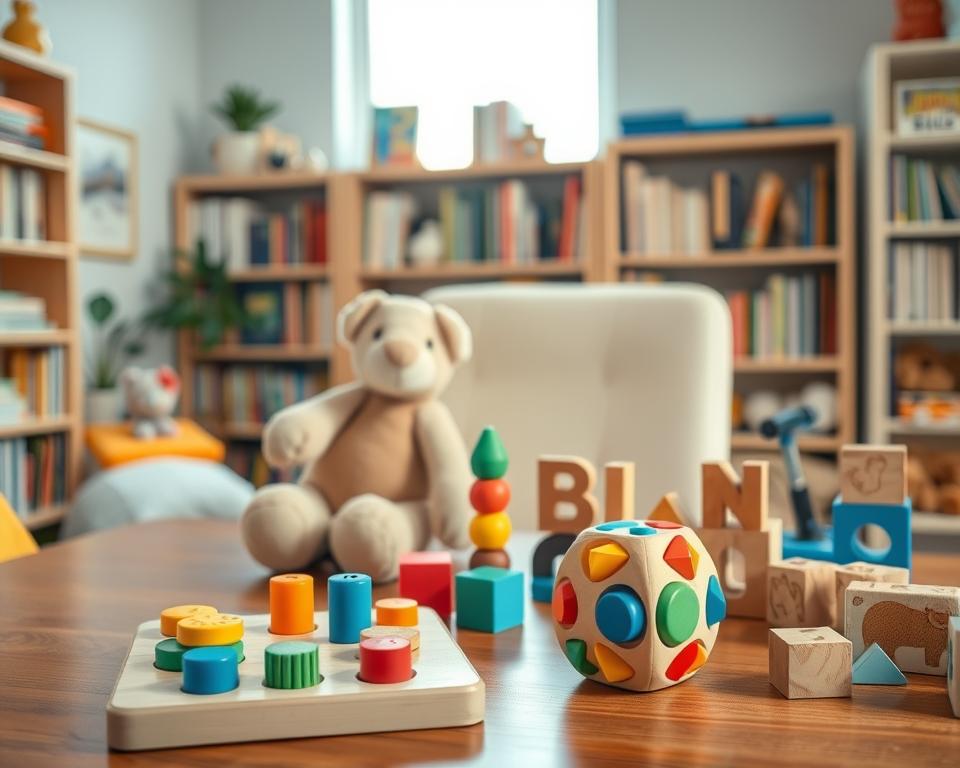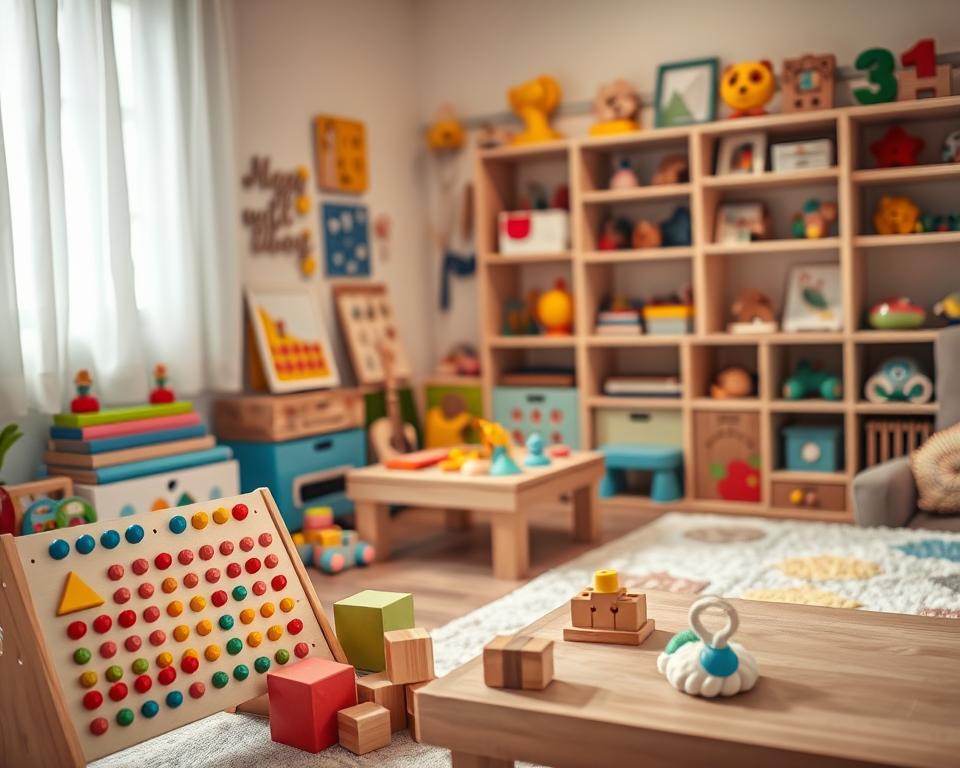Every parent wants to see their child thrive and reach their full potential. But for kids facing developmental challenges, achieving key milestones can feel like an uphill battle. The good news? You can support their growth right from your living room with the right tools.
Therapeutic toys are more than just playthings—they’re powerful tools designed to build essential skills. From improving motor coordination to enhancing cognitive abilities, these toys make learning fun and effective. Experts like Joan Jung-D’Amico have shown how home-based care can make a real difference in a child’s progress.
By choosing the right toys, you’re not just playing—you’re empowering your child to overcome challenges and succeed. Let’s explore how these tools can transform everyday moments into opportunities for growth.
Key Takeaways
- Therapeutic toys help children build essential skills through play.
- Home-based care supports developmental milestones effectively.
- Experts recommend using toys aligned with professional strategies.
- Parents play a key role in fostering their child’s growth.
- Choosing the right toys can make learning fun and impactful.
Why Developmental Therapy at Home Matters
The comfort of home can be a game-changer for your child’s progress. Unlike clinical settings, the environment at home is familiar and safe. This reduces stress and helps kids focus on learning. Joan Jung-D’Amico, a renowned expert, once said, “We can’t recreate home dynamics in hospitals.” This highlights the unique benefits of personalized care in a familiar space.
For toddlers, transitioning between activities can be challenging. Being in a familiar setting minimizes this stress. It allows them to focus on building skills rather than adjusting to a new place. Studies show that kids make faster progress when parents are actively involved. For example, teletherapy research reveals that parental participation boosts outcomes significantly.
Take the case of children with autism. They often engage better with toys they already know and love. This familiarity can lead to improved communication and social skills. Additionally, concepts like Individualized Education Programs (IEP) and Least Restrictive Environment (LRE) emphasize the importance of integrating care into daily life. Home-based services align perfectly with these principles.
By choosing to support your child’s development at home, you’re not just providing care—you’re creating a nurturing space where they can thrive. The involvement of family members further strengthens this process, making it a collaborative effort. Together, you can turn everyday moments into opportunities for growth.
What Are Developmental Therapy Toys?
Toys designed for therapy are more than just fun—they’re tools for growth. These specialized playthings are crafted to help your child build essential skills while having a great time. For example, a simple stacking block isn’t just a toy; it’s a fine motor skills builder.
Therapeutic toys often include features like textured surfaces or weighted components. These elements address sensory needs and enhance learning. Brands like Melissa & Doug are well-known for creating toys that align with occupational therapy goals.

Speech-focused toys, such as flashcards with visual cues, support communication and language development. Items like Chewy tubes are designed to strengthen oral motor skills, making them a favorite among professionals. These tools bridge the gap between play and professional treatments.
Here’s how therapy toys differ from regular ones:
- They target specific skills like coordination or socialization.
- They’re designed with sensory needs in mind.
- They align with strategies used by therapists.
By choosing the right toys, you’re giving yourchildthe tools they need to thrive.
Benefits of Using Therapy Toys at Home
The right toys can turn playtime into a powerful learning experience. These tools are designed to help your child build essential skills while having fun. Whether it’s improving coordination or boosting language, therapy toys make a real difference.
Enhancing Fine Motor Skills
Toys like playdough and stacking blocks are great for building fine motor skills. Squeezing and shaping playdough strengthens hand muscles, preparing kids for writing. Stacking blocks improves hand-eye coordination, a key focus in occupational therapy.
Puzzles are another excellent tool. They help children with autism develop problem-solving abilities. These activities are not just fun—they’re building blocks for future success.
Improving Communication and Language
Speech-focused toys, such as flashcards and toy-based sign language, support communication skills. One family shared how their child’s first words emerged through these tools. These toys make learning language engaging and effective.
Chewy tubes are another favorite. They strengthen oral motor skills, which are essential for clear speech. These tools align with speech therapy goals, making them a valuable addition to your home.
Building Social and Emotional Skills
Therapy toys also help children develop social skills. Interactive games encourage sharing and teamwork. Sensory toys like weighted blankets support emotional regulation, helping kids feel calm and focused.
Research from TherapyWorks shows that teletherapy combined with these toys leads to better outcomes. By integrating these tools into daily play, you’re fostering both emotional and social growth.
- Playdough strengthens grip for writing readiness.
- Puzzles enhance problem-solving in autism.
- Toy-based sign language aids first words.
- Weighted blankets support emotional regulation.
- Teletherapy results show improved progress.
How to Choose the Right Toys for Your Child
Selecting the right toys for your child can make a big difference in their growth. The best choices align with their unique needs and help them overcome specific challenges. Here’s how to make informed decisions that support their development.
- Is the toy age-appropriate for my child?
- Does it address a specific skill gap or motor need?
- Is it safe and durable for regular use?
- Does it align with my therapist’s recommendations?
For kids with sensory processing disorders, avoid toys that might cause overstimulation. Look for items with calming features, like soft textures or gentle sounds. Involving your child in the selection process can also help. Let them choose between two approved options to encourage engagement.
Don’t forget to check if your insurance covers therapeutic devices. Many plans include these tools as part of developmental support. Joan Jung-D’Amico emphasizes the importance of family collaboration in this process. By working together, you can create a nurturing environment that meets your child’s needs.
For more insights on improving motor skills, explore our detailed guide. Choosing the right toys isn’t just about play—it’s about empowering your child to thrive.
Top Developmental Therapy Toys for Different Age Groups
Finding the right tools for your child’s growth can be a game-changer. Toys tailored to their age and needs help build essential skills while keeping them engaged. Let’s explore the best options for infants, preschoolers, and school-aged children.
Toys for Infants and Toddlers
For infants, toys that encourage grasping and sensory exploration are key. The Oball Rattle is perfect for 6-12-month-olds. Its lightweight design helps babies practice fine motor skills while having fun.
DIY sensory bins are a budget-friendly option. Fill them with household items like rice or pasta for tactile play. Always ensure toys meet safety standards like ASTM F963 or AAP approval.
Toys for Preschoolers
Preschoolers thrive with toys that combine learning and play. Magna-Tiles are a favorite for STEM and social skills. These magnetic tiles encourage creativity and teamwork, making them ideal for group activities.
For kids with autism, puzzles are a great choice. They improve problem-solving and focus while being enjoyable. Look for toys that align with their interests to keep them engaged.
Toys for School-Aged Children
Older kids benefit from toys that challenge their minds. The Brainetics Kit is excellent for building executive functioning skills. It combines math and memory games to make learning exciting.
For speech development, consider flashcards with visual cues. These tools support language growth in a fun, interactive way. Always involve your child in the selection process to ensure they stay motivated.
By choosing age-appropriate toys, you’re giving your child the tools they need to succeed. Whether it’s improving motor skills or enhancing communication, the right toys make all the difference.
How Therapy Toys Support Occupational and Speech Therapy
Therapists often use toys as essential tools in their sessions to help children grow. These playthings are more than just fun—they’re carefully chosen to target specific skills. For example, Mr. Potato Head is a favorite in occupational therapy. It helps kids develop body awareness and fine motor skills by assembling parts.

In speech therapy, toys like flashcards and AAC devices play a big role. These tools encourage communication and language development. The Hanen Center’s parent-coaching model shows how parents can become co-therapists. By using these toys at home, families can reinforce what’s learned during professional sessions.
Studies show that combining clinic and home-based approaches leads to better progress. For instance, teletherapy allows parents to actively participate. This collaboration helps children achieve their goals faster. A case study of a nonverbal child using an AAC toy at home highlights this success. The child began forming words within weeks.
Here are some strategies therapists recommend:
- Use toys like puzzles to improve problem-solving skills.
- Incorporate sensory toys to address specific needs.
- Engage in interactive play to build social skills.
By working together,therapistsand families can create a supportive environment for growth.
Creating a Therapy-Friendly Environment at Home
Setting up a supportive space at home can make a big difference in your child’s progress. A well-organized environment helps them feel safe and focused, turning everyday moments into opportunities for growth. Here are practical tips to create a nurturing space that meets their needs.
Start by designing “Activity Stations” tailored to your child’s challenges. A quiet corner with soft pillows and calming toys can help with sensory regulation. A motor play area with stacking blocks or puzzles encourages physical and cognitive development. These zones provide structure while keeping activities engaging.
Lighting and acoustics play a key role in sensory care. Use dimmable lights to reduce overstimulation and soft rugs to minimize noise. Small adjustments like these can create a more comfortable environment for learning and play.
Involve your family in the process. Turn clean-up into a cooperative game to teach teamwork and responsibility. Siblings can play a vital role in creating a supportive atmosphere, making the experience enjoyable for everyone.
Safety is essential, especially when using physical support equipment. Secure furniture and remove sharp objects to prevent accidents. Regularly check toys and tools for wear and tear to ensure they remain safe for use.
Integrate therapy into daily routines to reinforce skills. For example, brushing teeth can double as oral motor practice. These small changes make care seamless and effective, helping your child thrive in a familiar setting.
- Design “Activity Stations” for focused play.
- Adjust lighting and acoustics for sensory needs.
- Involve siblings in clean-up and play.
- Safety-proof the space for physical activities.
- Blend therapy into daily routines for consistency.
By creating a therapy-friendly environment, you’re not just supporting your child’s growth—you’re building a foundation for lifelong success. With these tips, your home can become a place where learning and play go hand in hand.
Conclusion: Unlock Your Child’s Full Potential with Developmental Therapy Toys
Your child’s journey to reaching their full potential starts with the right tools. Through play, they can achieve key milestones like improved motor skills, better communication, and stronger social abilities. Early intervention and consistent practice at home maximize outcomes, making every moment a step toward growth.
Consulting with specialists from TherapyWorks can provide tailored strategies to support your child’s progress. Remember, you’re already equipped to be their first teacher. To make tracking easier, download our free progress tracker and celebrate every small win.
As Joan Jung-D’Amico wisely said, “Growth happens where love meets strategy.” Together, your team can create a nurturing environment that helps your child thrive in every aspect of life.
